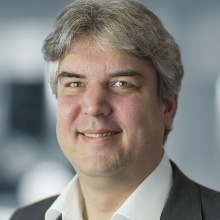On invitation, Dean Prof. Oliver Röhrle, Ph. D., visited the Stanford University in California, during a week in February for intense scientific exchange. In this context he gave a lecture entitled ‘Life is Motion: An Integrated View On The Neuromuscular System’.
Motion is a defining feature of human life allowing us to perform various tasks. Motion is typically the consequence of the chemo-electro-mechanical properties of muscles. Moreover, muscles can act as interface between the brain and the environment. As such, they provide us a window to the brain, to study, for example, control. Yet, despite more than a century of scientific effort, only a crude understanding of the entire mechanisms enabling motions, and hence the neuromuscular system and its force-generating capability exists. A fundamental challenge to study the neuromuscular system in-vivo is the lack of sophisticated experimental methods providing insights how human physical performance is mechanistically linked to the biophysical function of our body. This also limits the development and the assessment of therapies aiming to tackle the diverse class of neuromuscular disorders. Hence, novel methods to study the neuromuscular system in-vivo are desperately needed. Investigating the neuromuscular system requires an integrated approach for studying the biophysical basis of human motion. That is the combination of experimental methods, computational models and data science. While we perform research in all three areas, we focus within this talk on in silico models, particularly on continuum-mechanical, volumetric models of the neuromuscular system, as well as computational techniques to study motion and, hence, the neuromuscular system. The talk will, for example, address homogenization techniques for microstructurally motivated constitutive laws, methodologies to determine the system-inherent pre-stretches, the use of multi-scale chemo-electro-magneto-mechanical simulations to study neuromuscular recruitment (forward problem) and novel methodologies and emerging sensor technologies to better decompose the complex neural recruitment patterns resulting in muscular contraction (inverse/source localization problem) and hence motion.


